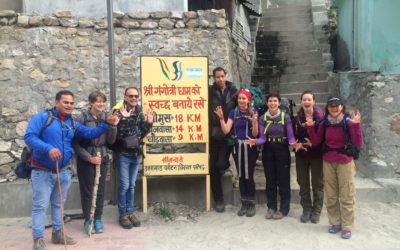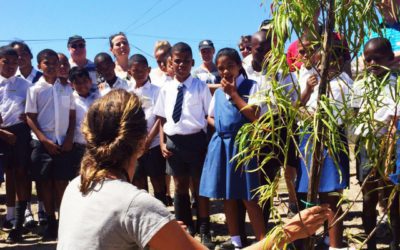Importance of urban greening
12
MARCH, 2021
By Charlotte Mostert
Urban greening combats air and noise pollution, soaks up rainwater reducing flooding, creates a habitat for local wildlife, and lifts morale in the people who see it, which calms traffic and lessens urban crime.
What is Urban Greening? It has been defined as creating a mutually beneficial relationship between people who reside in the city and the environment, through public landscaping and urban forestry.
Temperature:
Greening a city is one way of improving a cities microclimate. Traffic and industrial activity emit heat, while concrete traps heat, leading to urban air temperature being higher than in rural environments. This adaption of temperatures to hotter climates compels individuals to opt for air conditioners in order to stay cool. The introduction of cooling systems in the concrete jungle adds to the increasing energy demands and continues to emit more heat, worsening the urban heat island effect.
Studies have shown that green roofs result in up to a 75% reduction in demand for cooling and it improves the quality of water runoff on buildings, reducing the volume of pollutants entering watercourses. Through dry deposition pollutants such as microscopic particulate matter are trapped in the wax or cuticles of leaves reduces pollution and keeps cities cool in the increasingly scorching summers that lie ahead.
Flooding:
The impermeable surfaces that dominate the city prevent rainfall from being absorbed and accelerate the possibilities of flooding, leading to economic loss and disruption. Where vegetated surfaces absorb the majority of rainfall, inevitably slowing down the process of surface runoff reaching drainage capacity.
Economic Upliftment:
Urban greening presents a fantastic opportunity to drive economic growth, help businesses thrive, and boost tourism. Having vegetation on the property can increase its value. Investing in green infrastructure delivers a ten-fold increase in the initial investment in the project. With trees and other vegetation, a residential property can increase in value by 15-25%. Being situated near a well-managed greenspace would on average from 2.6% – 11.3% increase property premium.
Biodiversity:
The greening of a city creates a space for all living beings to come together. When there is a variety of different plants and trees in an area there is a resurgence of natural life, from insects to birds and in some cases mammals. One of the greatest accomplishments is that it unites humans with nature again, allowing humans to play barefoot on the grass while watching butterflies fly past and count the bird’s nests in the trees.
Community:
Green space encourages people to get outside and take part in physical activity. Studies show that there is an increase in social activities in green spaces up to 83%. There is a greater sense of community and social inclusion when encapsulated in green spaces.
Instead, it would be more financially beneficial and environmentally sustainable, in the long run, to plant green roofs and invest in having plants in the surrounding area. For trees and vegetation are natural cooling systems, through water that evaporates from their leaves when exposed to the sun’s rays, and by shading surfaces that otherwise might have absorbed heat. Trees communicate with one another through fungi that grow in their root, which provides the tree with nutrients. Through this network, they can share resources with one another, nicknamed “The Wood Wide Web”, as well as creating a path for larger trees to send nutrients to smaller trees in their shade. This structure is to ensure the survival of trees and plants are maintained.
At Greenpop Urban Greening is an important subject, there is a beautiful initiative Fynbos for the Future focusing on Urban greening through the conservation of fynbos and other indigenous flora in Cape Town. Sign up here to be apart of this magic!
There is a theory named the ‘broken window theory’ drawing on earlier research by Stanford University psychologist Philip Zimbardo has been defined in 1982 by social scientists James Wilson and George Kelling stating that one broken window in a community would soon lead to many more windows being broken. The negligence and disorder increase levels of fear among citizens, which leads them to withdraw from the community and decrease participation in informal social control. This has lead to the theory of if police address smaller crimes then the bigger crimes will be on a decline. Once smaller problems in neighborhoods are handled and order is restored, it leads to empowerment which prevents crime. Therefore focusing on restoring the environment by planting trees and increasing nature more visibly would stimulate a looked after neighborhood and decrease crime rates.
Pollutants:
Urban trees are effective air filters, removing harmful pollutants in the air, storing carbon which helps mitigate the impacts of climate change in and around urban areas. Therefore NASA has produced research identifying the top ten best plants to use in interior projects.
By greening cities, we can keep ourselves cool amid rising temperatures, reverse the steady erosion of the rich tapestry of life on Earth, and foster happiness and social connection in the process. Now that you understand the importance of urban greening, come get involved in being the change with Greenpop at the Eden Festival of Action, which will help plant hundreds of trees, reducing the heating and pollution on the planet!
Resources:
https://www.ansgroupglobal.com/news/importance-urban-greening
https://depts.washington.edu/hhwb/Thm_Crime.html
https://naturesmartcities.eu/public/library/Benefits%20of%20Urban%20Greening.pdf
https://www.youtube.com/watch?v=DUqEB_tGHtw
http://www.fao.org/fao-stories/article/en/c/1106849/
Pictures:
https://www.scotscape.co.uk/services/urban-greening-solutions#How-can-plants-help?
What is Farmer Managed Natural Regeneration (FMNR)?
What is Farmer Managed Natural Regeneration? 29 MARCH 2017 By Reini Marissens With climate change knocking on our door, increasing deforestation and droughts, the future sometimes looks very dark and scary. Even more for people who live close to nature and are...
Activist Spotlight: #TrekForTrees
Activist Spotlight: #TrekForTrees 16 FEBRUARY, 2017 By Ivy Pepin Being an active citizen means translating your passion into action. It might mean bringing your own bag to buy groceries. It might mean cooking a colorful vegan meal a few times a week. In one particular...
Greening Urban Spaces: January 2017
Greening Urban Spaces: January 2017 8 FEBRUARY, 2017 By Ivy Pepin We had just one planting day this month, on January 25th, and it was an energizing way to kick off a fresh new year of urban greening! The sun was already hot on our backs as we loaded up the bakkie to...
Greenpop Foundation NPC is a registered non-profit organisation. Registration Number (NPO): 151-411 NPO.





